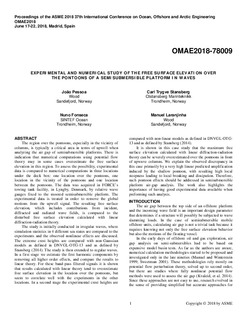| dc.contributor.author | Pessoa, João | |
| dc.contributor.author | Stansberg, Carl Trygve | |
| dc.contributor.author | Fonseca, Nuno | |
| dc.contributor.author | Laranjinha, Manuel | |
| dc.date.accessioned | 2019-03-26T07:43:18Z | |
| dc.date.available | 2019-03-26T07:43:18Z | |
| dc.date.created | 2018-09-27T13:36:43Z | |
| dc.date.issued | 2018-06-25 | |
| dc.identifier.citation | ASME 2018 37th International Conference on Ocean, Offshore and Arctic Engineering - Volume 1: Offshore Technology | nb_NO |
| dc.identifier.isbn | 978-0-7918-5120-3 | |
| dc.identifier.uri | http://hdl.handle.net/11250/2591687 | |
| dc.description.abstract | The region over the pontoons, especially in the vicinity of columns, is typically a critical area in terms of upwell when analyzing the air gap of semisubmersible platforms. There is indication that numerical computations using potential flow theory may in some cases overestimate the free surface elevation in this region. To assess the possibility, experimental data is compared to numerical computations in three locations under the deck box: one location over the pontoons, one location in the vicinity of the pontoons and one location between the pontoons. The data was acquired in FORCE’s towing tank facility, in Lyngby, Denmark, by relative wave gauges fixed to the moored semisubmersible platform. The experimental data is treated in order to remove the global motions from the upwell signal. The resulting free surface elevation, which includes contributions from incident, diffracted and radiated wave fields, is compared to the disturbed free surface elevation calculated with linear diffraction-radiation theory. The study is initially conducted in irregular waves, where simulation statistics in 4 different sea states are compared to the experiments and the observed nonlinear effects are discussed. The extreme crest heights are compared with non-Gaussian models as defined in DNVGL-OTG-13 and as defined by Stansberg (2014). The study is then extended to regular waves. In a first stage we estimate the first harmonic components by removing all higher order effects, and compare the results to linear theory. For these band-pass filtered signals it is shown that results calculated with linear theory tend to overestimate free surface elevation in the location over the pontoons, but seem to correlate well with the experiments in the other locations. In a second stage the experimental crest heights are compared with non-linear models as defined in DNVGL-OTG-13 and as defined by Stansberg (2014). It is shown in this case study that the maximum free surface elevation over the pontoons in front of upwave columns can be severely overestimated if calculated with the current state of the art numerical models, which are based on linear diffraction-radiation theory. We explain the observed discrepancy in this case primarily by a very high linear predicted amplification induced by the shallow pontoon, with resulting high local steepness leading to local breaking and dissipation. Therefore, such pontoon effects should be addressed in semisubmersible platform air-gap analysis. The work also highlights the importance of having good experimental data available when preforming such analysis. | nb_NO |
| dc.description.abstract | Experimental and Numerical Study of the Free Surface Elevation Over the Pontoons of a Semisubmersible Platform in Waves | nb_NO |
| dc.language.iso | eng | nb_NO |
| dc.publisher | ASME | nb_NO |
| dc.relation.ispartof | ASME 2018 37th International Conference on Ocean, Offshore and Arctic Engineering - Volume 1: Offshore Technology - | |
| dc.relation.ispartofseries | ASME 2018 37th International Conference on Ocean, Offshore and Arctic Engineering - Volume 1: Offshore Technology;OMAE2018-78009 | |
| dc.rights | Attribution-NonCommercial-NoDerivatives 4.0 Internasjonal | * |
| dc.rights.uri | http://creativecommons.org/licenses/by-nc-nd/4.0/deed.no | * |
| dc.subject | Waves | nb_NO |
| dc.subject | Semi-submersible offshore structures | nb_NO |
| dc.title | Experimental and Numerical Study of the Free Surface Elevation Over the Pontoons of a Semisubmersible Platform in Waves | nb_NO |
| dc.type | Chapter | nb_NO |
| dc.description.version | acceptedVersion | nb_NO |
| dc.source.journal | ASME Digital Journal | nb_NO |
| dc.identifier.doi | 10.1115/OMAE2018-78009 | |
| dc.identifier.cristin | 1614923 | |
| cristin.unitcode | 7566,9,0,0 | |
| cristin.unitname | Skip og havkonstruksjoner | |
| cristin.ispublished | true | |
| cristin.fulltext | postprint | |
| cristin.qualitycode | 1 | |

